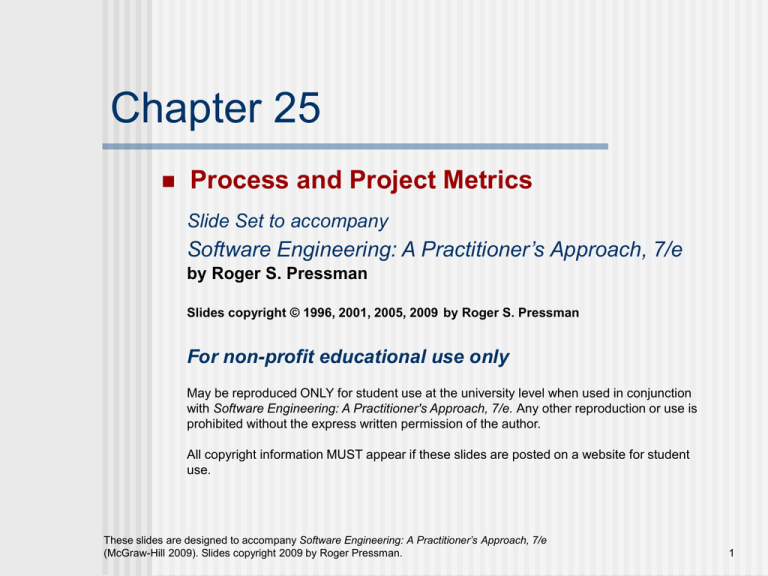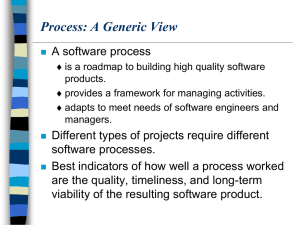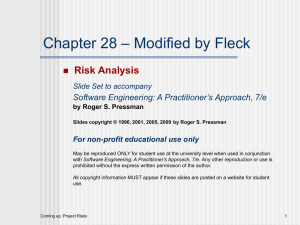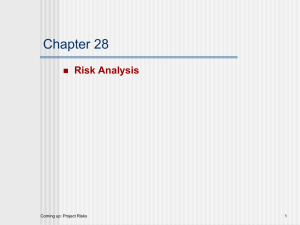Process and Project Metrics in Software Engineering
advertisement

Chapter 25 Process and Project Metrics Slide Set to accompany Software Engineering: A Practitioner’s Approach, 7/e by Roger S. Pressman Slides copyright © 1996, 2001, 2005, 2009 by Roger S. Pressman For non-profit educational use only May be reproduced ONLY for student use at the university level when used in conjunction with Software Engineering: A Practitioner's Approach, 7/e. Any other reproduction or use is prohibited without the express written permission of the author. All copyright information MUST appear if these slides are posted on a website for student use. These slides are designed to accompany Software Engineering: A Practitioner’s Approach, 7/e (McGraw-Hill 2009). Slides copyright 2009 by Roger Pressman. 1 A Good Manager Measures process process metrics project metrics measurement product metrics product What do we use as a basis? • size? • function? These slides are designed to accompany Software Engineering: A Practitioner’s Approach, 7/e (McGraw-Hill 2009). Slides copyright 2009 by Roger Pressman. 2 Why Do We Measure? assess the status of an ongoing project track potential risks uncover problem areas before they go “critical,” adjust work flow or tasks, evaluate the project team’s ability to control quality of software work products. These slides are designed to accompany Software Engineering: A Practitioner’s Approach, 7/e (McGraw-Hill 2009). Slides copyright 2009 by Roger Pressman. 3 Process Measurement We measure the efficacy of a software process indirectly. That is, we derive a set of metrics based on the outcomes that can be derived from the process. Outcomes include • measures of errors uncovered before release of the software • defects delivered to and reported by end-users • work products delivered (productivity) • human effort expended • calendar time expended • schedule conformance • other measures. We also derive process metrics by measuring the characteristics of specific software engineering tasks. These slides are designed to accompany Software Engineering: A Practitioner’s Approach, 7/e (McGraw-Hill 2009). Slides copyright 2009 by Roger Pressman. 4 Process Metrics Guidelines Use common sense and organizational sensitivity when interpreting metrics data. Provide regular feedback to the individuals and teams who collect measures and metrics. Don’t use metrics to appraise individuals. Work with practitioners and teams to set clear goals and metrics that will be used to achieve them. Never use metrics to threaten individuals or teams. Metrics data that indicate a problem area should not be considered “negative.” These data are merely an indicator for process improvement. Don’t obsess on a single metric to the exclusion of other important metrics. These slides are designed to accompany Software Engineering: A Practitioner’s Approach, 7/e (McGraw-Hill 2009). Slides copyright 2009 by Roger Pressman. 5 Software Process Improvement Process model Process improvement recommendations Improvement goals Process metrics SPI These slides are designed to accompany Software Engineering: A Practitioner’s Approach, 7/e (McGraw-Hill 2009). Slides copyright 2009 by Roger Pressman. 6 Process Metrics Quality-related Productivity-related error categorization & analysis Defect removal efficiency Production of work-products related to effort expended Statistical SQA data focus on quality of work products and deliverables propagation of errors from process activity to activity Reuse data The number of components produced and their degree of reusability These slides are designed to accompany Software Engineering: A Practitioner’s Approach, 7/e (McGraw-Hill 2009). Slides copyright 2009 by Roger Pressman. 7 Project Metrics used to minimize the development schedule by making the adjustments necessary to avoid delays and mitigate potential problems and risks used to assess product quality on an ongoing basis and, when necessary, modify the technical approach to improve quality. every project should measure: inputs—measures of the resources (e.g., people, tools) required to do the work. outputs—measures of the deliverables or work products created during the software engineering process. results—measures that indicate the effectiveness of the deliverables. These slides are designed to accompany Software Engineering: A Practitioner’s Approach, 7/e (McGraw-Hill 2009). Slides copyright 2009 by Roger Pressman. 8 Typical Project Metrics Effort/time per software engineering task Errors uncovered per review hour Scheduled vs. actual milestone dates Changes (number) and their characteristics Distribution of effort on software engineering tasks These slides are designed to accompany Software Engineering: A Practitioner’s Approach, 7/e (McGraw-Hill 2009). Slides copyright 2009 by Roger Pressman. 9 Metrics Guidelines Use common sense and organizational sensitivity when interpreting metrics data. Provide regular feedback to the individuals and teams who have worked to collect measures and metrics. Don’t use metrics to appraise individuals. Work with practitioners and teams to set clear goals and metrics that will be used to achieve them. Never use metrics to threaten individuals or teams. Metrics data that indicate a problem area should not be considered “negative.” These data are merely an indicator for process improvement. Don’t obsess on a single metric to the exclusion of other important metrics. These slides are designed to accompany Software Engineering: A Practitioner’s Approach, 7/e (McGraw-Hill 2009). Slides copyright 2009 by Roger Pressman. 10 Typical Size-Oriented Metrics errors per KLOC (thousand lines of code) defects per KLOC $ per LOC pages of documentation per KLOC errors per person-month errors per review hour LOC per person-month $ per page of documentation These slides are designed to accompany Software Engineering: A Practitioner’s Approach, 7/e (McGraw-Hill 2009). Slides copyright 2009 by Roger Pressman. 11 Typical Function-Oriented Metrics errors per FP (thousand lines of code) defects per FP $ per FP pages of documentation per FP FP per person-month These slides are designed to accompany Software Engineering: A Practitioner’s Approach, 7/e (McGraw-Hill 2009). Slides copyright 2009 by Roger Pressman. 12 Comparing LOC and FP Programming Language Ada Assembler C C++ COBOL Java JavaScript Perl PL/1 Powerbuilder SAS Smalltalk SQL Visual Basic LOC per Function point avg. median low high 154 337 162 66 315 109 53 104 91 33 29 205 694 704 178 77 63 58 60 78 32 40 26 40 47 77 53 63 67 31 41 19 37 42 14 77 42 22 11 33 10 7 16 400 75 263 105 49 55 110 158 Representative values developed by QSM These slides are designed to accompany Software Engineering: A Practitioner’s Approach, 7/e (McGraw-Hill 2009). Slides copyright 2009 by Roger Pressman. 13 Why Opt for FP? Programming language independent Used readily countable characteristics that are determined early in the software process Does not “penalize” inventive (short) implementations that use fewer LOC that other more clumsy versions Makes it easier to measure the impact of reusable components These slides are designed to accompany Software Engineering: A Practitioner’s Approach, 7/e (McGraw-Hill 2009). Slides copyright 2009 by Roger Pressman. 14 Object-Oriented Metrics Number of scenario scripts (use-cases) Number of support classes (required to implement the system but are not immediately related to the problem domain) Average number of support classes per key class (analysis class) Number of subsystems (an aggregation of classes that support a function that is visible to the end-user of a system) These slides are designed to accompany Software Engineering: A Practitioner’s Approach, 7/e (McGraw-Hill 2009). Slides copyright 2009 by Roger Pressman. 15 WebApp Project Metrics Number of static Web pages (the end-user has no control over the content displayed on the page) Number of dynamic Web pages (end-user actions result in customized content displayed on the page) Number of internal page links (internal page links are pointers that provide a hyperlink to some other Web page within the WebApp) Number of persistent data objects Number of external systems interfaced Number of static content objects Number of dynamic content objects Number of executable functions These slides are designed to accompany Software Engineering: A Practitioner’s Approach, 7/e (McGraw-Hill 2009). Slides copyright 2009 by Roger Pressman. 16 Measuring Quality Correctness — the degree to which a program operates according to specification Maintainability—the degree to which a program is amenable to change Integrity—the degree to which a program is impervious to outside attack Usability—the degree to which a program is easy to use These slides are designed to accompany Software Engineering: A Practitioner’s Approach, 7/e (McGraw-Hill 2009). Slides copyright 2009 by Roger Pressman. 17 Defect Removal Efficiency DRE = E /(E + D) where: E is the number of errors found before delivery of the software to the end-user D is the number of defects found after delivery. These slides are designed to accompany Software Engineering: A Practitioner’s Approach, 7/e (McGraw-Hill 2009). Slides copyright 2009 by Roger Pressman. 18 Metrics for Small Organizations time (hours or days) elapsed from the time a request is made until evaluation is complete, tqueue. effort (person-hours) to perform the evaluation, Weval. time (hours or days) elapsed from completion of evaluation to assignment of change order to personnel, teval. effort (person-hours) required to make the change, Wchange. time required (hours or days) to make the change, tchange. errors uncovered during work to make change, Echange. defects uncovered after change is released to the customer base, Dchange. These slides are designed to accompany Software Engineering: A Practitioner’s Approach, 7/e (McGraw-Hill 2009). Slides copyright 2009 by Roger Pressman. 19 Establishing a Metrics Program Identify your business goals. Identify what you want to know or learn. Identify your subgoals. Identify the entities and attributes related to your subgoals. Formalize your measurement goals. Identify quantifiable questions and the related indicators that you will use to help you achieve your measurement goals. Identify the data elements that you will collect to construct the indicators that help answer your questions. Define the measures to be used, and make these definitions operational. Identify the actions that you will take to implement the measures. Prepare a plan for implementing the measures. These slides are designed to accompany Software Engineering: A Practitioner’s Approach, 7/e (McGraw-Hill 2009). Slides copyright 2009 by Roger Pressman. 20







